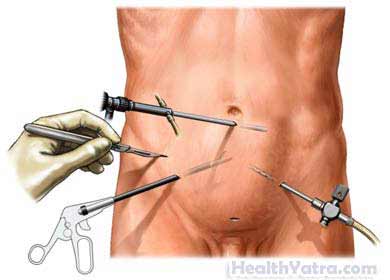সংজ্ঞা
Laparoscopy is a type of surgery done through several small incisions in the abdomen. Small tools and a laparoscope (tiny camera) are placed through the incisions to allow the surgeon to see inside the belly and perform surgical tasks. This type of surgery is very popular, as it usually shortens recovery time. It also leaves only very small scars in most cases.

পদ্ধতির কারণ
Many types of surgery can now be done with a laparoscope. Some examples include:
- Hernia repair
- Biopsy of abdominal organs
- Appendectomy
- কোলেক্টমি
- Gallbladder or gallstone removal
- Tubal ligation
- Ectopic pregnancy surgery
- হিস্টেরেক্টমি
- Fibroid tumor removal
- Adrenal gland removal
- স্প্লেনেক্টমি
- Lysis of adhesions in abdomen
It can also be done to help make a diagnosis.
সম্ভাব্য জটিলতা
Complications are rare, but no procedure is completely free of risk. If you are planning to have a laparoscopy, your doctor will review a list of possible complications, which may include:
- সংক্রমণ
- রক্তপাত
- Damage to blood vessels or organs
- Problems related to anesthesia
- The need for open surgery rather than laparoscopic surgery
জটিলতার ঝুঁকি বাড়াতে পারে এমন কারণগুলির মধ্যে রয়েছে:
- ধূমপান
- স্থূলতা
- Heart or lung condition
- Previous abdominal surgery
- ডায়াবেটিস
কি আশা করছ
পদ্ধতির আগে
Depending on the reason for your surgery, your doctor may do the following:
- Physical exam and review of medicines
- Blood tests (such as, pregnancy test, liver function, electrolyte status)
- Urinalysis to detect urinary tract infection and diabetes
- Ultrasound—a test that uses sound waves to visualize the inside of the body
- সিটি স্ক্যান—এক ধরনের এক্স-রে যা শরীরের ভেতরের ছবি তুলতে কম্পিউটার ব্যবহার করে
- এমআরআই স্ক্যান- এমন একটি পরীক্ষা যা চৌম্বক তরঙ্গ ব্যবহার করে শরীরের ভিতরের ছবি তৈরি করে
আপনার পদ্ধতির দিকে এগিয়ে যাওয়ার দিনগুলিতে:
- Depending on the অস্ত্রোপচারের ধরন, you may need to take a laxative or use an enema.
- Arrange for a ride home.
- The night before, eat a light meal. Unless told otherwise by your doctor, do not eat or drink anything after midnight.
Talk to your doctor about the medicines you are taking. Up to one week before the procedure, you may be asked to stop taking some medicines such as:
- অ্যাসপিরিন বা অন্যান্য প্রদাহ বিরোধী ওষুধ
- রক্ত পাতলাকারী, যেমন ক্লোপিডোগ্রেল (প্লাভিক্স) বা ওয়ারফারিন (কুমাদিন)
এনেস্থেশিয়া
Most commonly, you will have general anesthesia—You will be asleep.
পদ্ধতির বর্ণনা
After you are asleep and do not feel any pain, a needle will be inserted to inject carbon dioxide into your abdomen. The gas will make your abdomen expand. This will make it easier to see the organs. The laparoscope will then be inserted through a small hole that is cut in the skin. The laparoscope lights, magnifies, and projects an image onto a video screen. The area will then be inspected.
If necessary, several other incisions will be made in the abdomen. Tiny tools will be inserted to take biopsies or do surgery. The incisions will be closed with stitches or clips.
এতে কতক্ষণ সময় লাগবে?
This varies greatly depending on the procedure
এটা আঘাত করবে?
Anesthesia will prevent pain during the procedure. You may have soreness for a দুই দিন during recovery. Ask your doctor about pain medicine to help manage pain. You may also feel bloated or have pain in your shoulder from the gas. This can last up to three days.
পোস্ট-প্রক্রিয়া যত্ন
Once home, follow your doctor’s instructions, which may include:
- Remove the dressing the morning after surgery.
- ভারী উত্তোলন এড়িয়ে চলুন।
- Do not drink carbonated beverages for two days.
Ask your doctor about when it is safe to shower, bathe, or soak in water. You should be able to go back to regular activities in about one week. If the procedure was done to help diagnose a condition, your doctor will suggest চিকিত্সার বিকল্প. Biopsy results may take up to a week to come back.
আপনার ডাক্তারকে কল করুন
After arriving home, contact your doctor if any of the following occur:
- জ্বর এবং ঠাণ্ডা সহ সংক্রমণের লক্ষণ
- লালভাব, ফোলাভাব, ক্রমবর্ধমান ব্যথা, অত্যধিক রক্তপাত, বা কাটা স্থান থেকে স্রাব
- Nausea and/or vomiting that you cannot control with the medications you were given after surgery, or which persist for more than two days after discharge from the hospital
- ব্যথা যা আপনি ওষুধ দিয়ে নিয়ন্ত্রণ করতে পারবেন না
- Headache, muscle aches, feeling faint or dizzy
- ব্যথা, জ্বালা, জরুরী বা প্রস্রাবের ফ্রিকোয়েন্সি, বা প্রস্রাবে অবিরাম রক্তপাত
- Difficulty urinating or having a bowel movement
- কাশি, শ্বাসকষ্ট বা বুকে ব্যথা
জরুরী পরিস্থিতিতে, অবিলম্বে চিকিৎসা সহায়তার জন্য কল করুন।
